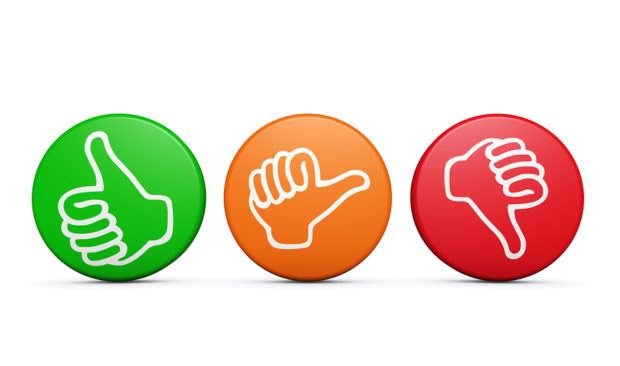Fourteen years ago, an executive at Bain & Co had a suggestion — create a short consumer survey to test brand loyalty. The idea took off, so much so that the executive, Fred Reichheld, has watched it morph into a Frankenstein: the endless loop of “brief” satisfaction surveys following a dental appointment, car rental or salad at a corner restaurant.
Not only are the requests inescapable, but employees increasingly pressure, even bribe, customers to offer only the highest marks, raising real questions about the results.
Reichheld came face to face with the monster he unwittingly helped spawn when he recently entered a hotel lobby where a sign read, “If there’s any reason you can’t give us a 10, stop by the front desk. We’ll make it worth your while.”
That hotel is no outlier. An Allstate insurance agency in Westchester, New York, sends customers frequent notes pushing them to give it a flawless score on an e-mailed survey by saying the customers will benefit: “Each time we obtain a ‘Perfect 10’ on the survey, our agency is given additional resources from Allstate that will allow us to provide our clients with an even higher level of service.”
Trump University
Trump University students who have sued for false promises have testified that they were pressured to give high marks to professors. Uber riders are familiar with the not-so-gentle demand from drivers for five stars out of five.
The explosive growth in instant customer surveys results from a confluence of forces, scholars say: the growing thirst for client feedback to improve products and services; the increasing focus on data; the ease of reaching customers via e-mail and text; and the growing conviction that by rating a product, customers gain a stake in it, that they become members of that product’s “community.”
“There was a time in marketing where the consumer was on the sidelines,” said Vann Graves, chief executive officer of FL+G, an advertising and marketing company. “Now this idea of participatory marketing helps to engage people. It’s like, ‘I’m affecting the brand by participating.'”
Those under 35 have grown used to this approach and consult many online reviews before making a purchase, according to Nora Ganim Barnes, professor of marketing at the University of Massachusetts-Dartmouth.
But the tsunami of surveys — more than two-thirds of Fortune 1000 companies use the Net Promoter System started by Reichheld, according to Bain — is making them far less useful, Graves said, and change seems inevitable.
Foot Cream on Twitter
There was a time, he noted by way of example, when every brand thought it necessary to have a Facebook page or Twitter handle. “Do I really care if Pepto-Bismol has a Facebook page?” he asked. “Do I really want to follow my foot cream on Twitter?”
“We’re just in the middle of everybody doing it,” he said. “It works for a lot of service oriented things, but I’m not going to rate my toilet paper online.”
Context is clearly important. TripAdvisor Inc. doesn’t face survey fatigue, according to Brian Payea, head of industry relations, because people want others to learn of their travel experiences.
“It’s the thing you want to share, whereas the fertilizer I bought and the deck-paint I bought that I got requests to review, it’s like, ‘Hmm, not that passionate about it,”‘ he said.
Problems with surveys are two-fold, researchers said. First, too many surveys with too many questions turn off consumers. Second, results that are tied to employee bonuses — or jobs — prove inaccurate. Combined, these problems are turning a useful method of interacting with customers into a headache.
People are losing patience. Pew Research telephone poll respondents fell from 36 percent in 1997 to 9 percent in 2012, according to a company report. The number is likely even lower today.
Survey Fatigue
Those who do respond often do not make it through the whole survey, especially if it’s longer than a couple of questions. Each minute, 2 to 4 percent of respondents abandon the cause, according to a 2015 retail industry study by Medallia Inc., a consumer experience research company.
“Survey fatigue is a real (and growing) problem facing anyone who wants to collect data,” wrote Andrea Fryrear, in a SurveyGizmo blog post Feb. 25. “If we want to be able to continue to get information from an audience, we have to design survey projects that are respectful of their time.”
For Michelle Henry, co-founder and president of the Akron, Ohio-based Center for Marketing and Opinion Research LLC, the solution to the problem of consumer turnoff is giving more thoughtful surveys just once or twice a year aimed specifically at helping improve products.
The wrong way is tying surveys to compensation or benefits and having the employees give them, she said, like some restaurants where waiters ask customers to fill out a survey and put in a good word for them.
Customer Ill Will
In a letter to the editor of Automotive News in 2013, Ronald Russo, executive manager at Vaden Automotive Group in Savannah, Georgia, complained that survey fatigue was leading to customer ill will and harsh responses.
“If our dealership gets poor survey ratings because customers state they are tired of receiving surveys, the manufacturers will count that against us,” he wrote.
Meanwhile, Reichheld said, bloated ratings defeat the purpose. Coaching responses can drive scores up, yet higher scores indicate nothing about whether the customer will return or recommend.
“The instant we have a technology to minimize surveys, I’m the first one on that bandwagon,” Reichheld said.





















 Rebuilding Negotiation Talent: Why This Skill Is Missing and How to Fix It
Rebuilding Negotiation Talent: Why This Skill Is Missing and How to Fix It  ‘Dream Is in Sight:’ Chamber, Reinsurers, Insurers Urge Florida to Stay the Course
‘Dream Is in Sight:’ Chamber, Reinsurers, Insurers Urge Florida to Stay the Course  The Future of Knowledge in Insurance: From Training to AI-Powered Productivity
The Future of Knowledge in Insurance: From Training to AI-Powered Productivity  How One MGU Grew Fivefold When Capacity Fled Cat-Prone Property Markets
How One MGU Grew Fivefold When Capacity Fled Cat-Prone Property Markets 


